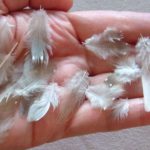Moult
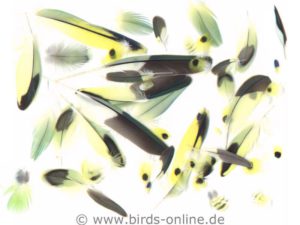
The moulting of a bird is a natural process that regularly takes place and happens several times in the animal’s life. During the moult, the plumage is renewed. This process fulfils an important function and should not be confused with a plumage disorder or even a disease. But in some birds, we see moulting disorders of different kinds. To recognize these and to be able to take action against the respective problems, however, it is important to know all the facts about a regular moult. In this chapter, you will find information about this process and also find related topics.
Why do birds moult?
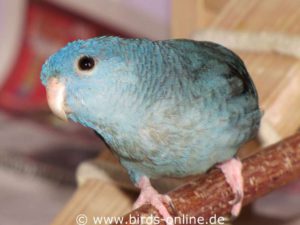
Feathers perform many tasks: They serve as protection against weather conditions and sunlight, they prevent injuries because they stand as a barrier between the skin and, for example, scratching branches, and they are needed for flying. Last but not least, feathers are especially important for the male birds in the display because only those who have shiny, intact plumage are attractive partners for the females.
In nature, the feathers are exposed to various influences that lead to natural wear. Examples include dust and other dirt particles. While they’re battling for territory, over food or a partner, the feathers of the opponents are exposed to mechanical stress. And especially while raising their young, the feathers of the adult birds have to stand the strains of rubbing against the nest or the walls of the nesting cavity, which can cause abrasion or even lead to kinks.
Because fully grown feathers can not regenerate, they are repelled by the body after a certain time and the birds grow new feathers – this process is called moulting.
How does a regular moult proceed?
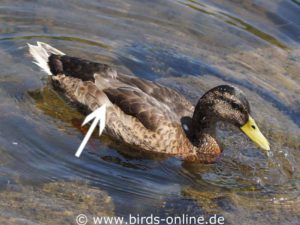
There are more than 10,000 bird species in the world that not only look different but have also developed different strategies for moulting. Most songbirds moult after rearing the young because the plumage was exposed to particularly strong loads during this phase. Not all large feathers on the wings are renewed same time so that the birds usually remain able to fly.
Ducks show a different moulting pattern. They lose all large wing feathers at once and are flightless for a few weeks. Since they can swim on waters where they also find their food, this temporary inability to fly is usually not a problem. However, during this time they permanently have to watch for predators because the ducks cannot flee flying. Instead, they have to swim away or dive.
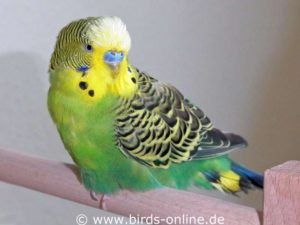
Unlike ducks, budgies and many other pet birds remain able to fly during a regular moult. In general, they do not show any bald areas on the body as part of a regular moult. At most, this can occur in very old individuals. There is no fixed “moulting schedule” in the budgies. Each bird moults during individual periods and adult birds renew their plumage two to three times a year. Above all, the natural change of the large feathers on the wings and tail is noticeable to the owner, because often these large feathers can be found on the ground. Now and then, small feathers covering the bird’s body, i.e. the feathers on the head, breast and back as well as the warming dunes, which are a kind of “underwear”, can occasionally be found on the floor. While the birds are moulting, however, these smaller feathers are renewed in larger numbers.
In some cases, it happens that several large feathers on the wings are renewed at the same time, so the bird’s ability to fly is limited temporarily. This can even be heard: The fact that gaps form between the large feathers because some are missing causes some noise while the birds are on the wings. Most adult birds know how to deal with this “handicap”. But young birds who are not yet very keen flyers may struggle with the situation during their post-juvenile moult. In some cases, the large feathers will not all grow back during the post-juvenile moult. If you observe this in one of your birds, you should make an appointment with your avian vet. In many budgies, diseases caused by for example polyomavirus are responsible for this condition.
What happens during the moult?
A bird’S feathers are firmly anchored in the skin. If a feather is torn out, the bird feels pain and sometimes small bleeding occurs. The situation is different during the moult. The old feathers detach from the skin and eventually fall out. As far as we know so far, this process doesn’t cause any pain. Instead, they seem to feel a kind of itching.
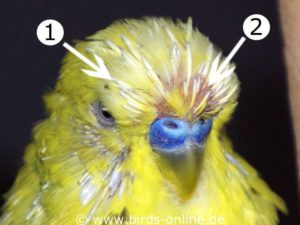
Within the next few days (or weeks), new feathers grow where the old ones have been. Growing feathers are supplied with blood, they are called blood feathers in this stadium, see mark 2. Sometimes, birds scratch or bump into something and the blood feathers are injured. In case a small blood feather on the forehead of a bird is broken, there is no reason to worry. The bleeding will most probably stop within an instance. A red spot remains in the plumage for a few days, in some birds, small blood crusts can also be seen in the plumage.
But let’s get back to the new feathers. They form inside a thin, translucent to whitish cover, see mark 1 in the figure near this paragraph. As soon as the new feather is ready to unfold, this cover bursts open
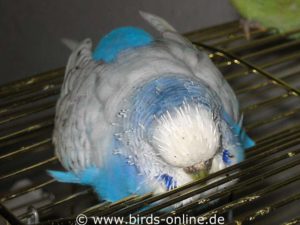
Young birds usually do not care much about moulting. During moulting, many adult birds are calmer than usual, because building new feathers consumes a lot of energy. Older animals in particular sleep quite often while they’re moulting. Some are extremely irritable. If anything bothers them, they tend to become aggressive and start biting. Very old birds, such as budgies who are older than ten or twelve years, may have a higher need for sleep during moulting than outside moulting times. Make sure they can take their rest and go through this exhausting process. And keep an eye on the room temperature. It should be at least 15 °C for birds kept indoors. For very old birds it may also be slightly warmer.
Supporting measures during moulting
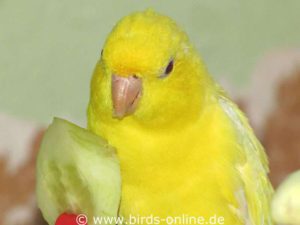
To make it easier for a bird to moult naturally, you should give it as much rest as possible so that it can spare its strength and invest the energy saved in growing new feathers. The body also needs a lot of energy and a large number of nutrients. It is therefore of great importance, especially during moulting, to ensure a balanced, nutrient-rich diet.
For example, cucumber is a kind of “power food” for moulting birds. The mineral salts contained in it support the natural growth of feathers. You can serve cucumber every day – not only while your birds are moulting. Detailed information on the supportive diet during the moult can be found in a special chapter in the future.
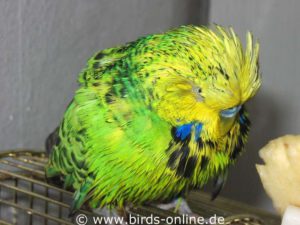
There is another thing you can do for your birds while they’re moulting. Many birds love to bathe or shower at least once a day while their new feathers are growing. Whether it relieves their itching or frees the regrowing feathers more quickly from the thin covers when the birds soak their plumage is not yet scientifically proven. But in the end, this should not matter anyway, because what the animals like usually does them good in one way or another. After bathing/showering, the birds should be able to dry their plumage in a quiet, draught-free place. Many of them love to take a nap afterwards. It seems to be the best way for them to get through the stressful time.
If the moult is unusual
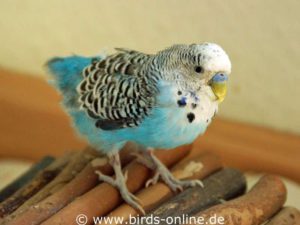
In addition to a regular and natural mould, birds occasionally also experience unusual courses, some of which are caused by diseases. An undersupply of nutrients, i.e. an unbalanced diet, can also be a reason for a moulting disorder in budgies and other pet birds. Because this topic is wide-ranging and it is extremely difficult to assess the cause, it always makes sense to consult an avian vet. There will be more information here in the future. Texts on several related topics are not yet translated (sorry!).

